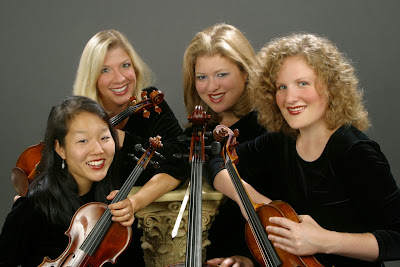Cleveland
Institute of Music
December
4
 |
| World-class music from two star player/pedagogues. |
From
the moment that Ivan Ženatý
and Sandra Shapiro walked onstage at Mixon Hall on Wednesday night,
it was clear that the audience was in for something special. Coming
off a six-city American and European tour, the duo was the picture of
sophisticated elegance, with Ženatý
in formal black tie and tails, and Shapiro resplendent in a glittery
silver-grey evening gown.
Their
music was even more impressive. Ženatý
is a virtuoso Czech violinist who embodies the Central European sound
– warm, full, richly emotional and technically precise. He plays
with a regal bearing and beautiful purity of tone enhanced by his
instrument, a 1740 Guarneri. Shapiro is a piano prodigy and Juilliard
graduate who imparts a bright, sensitive quality to everything she
touches, a skilled chamber music performer who plays with
intelligence and grace. Both are seasoned performers on the
international circuit as well as faculty members at CIM.
The
caliber of the music they play together is world-class, though in
some ways their recital was equally interesting as a demonstration of
how
to play duets. Ženatý is
a punctilious, intensely focused performer who will not start while
there is the slightest noise or distraction – not as an ego
exercise, but as a show of respect for the music. He and Shapiro have
distinct voices that fit together seamlessly when they play, matching
surges of expression and nuances of phrasing and tone, or opening up
space for each other to dash off a dazzling line. Their sound is
airtight and commanding, with sharp, precise beginnings and endings
on every piece.
Their
opening selection was a gift: Dvořák’s Romantic
Pieces for Violin and Piano
(Op. 75), music that runs in every Czech player’s blood. Ženatý
rendered it with drama and flair, putting passionate fervor in the
familiar “Allegro Maestoso” melody, and tugging at the
heartstrings in the “Allegro appassionato.” Shapiro provided
propulsive rhythms and an array of subtle colors, adding tasteful
accents to the music. Their dreamy fadeout in the closing “Larghetto”
was soft as a whisper.
 |
| Textbook duet work. |
Schumann’s
Sonata in D minor for
Violin and Piano (Op.
121) offered both a visual and musical study. Standing next to
Shapiro, Ženatý would
lean in to draw out extended notes and phrases with her, driving
their interpretation of the piece and keeping it in perfect synch.
Their tandem work was riveting, but the divergent melodies were even
more compelling, linked together so intricately that they spoke with one voice. Overall, the shading and expression were so
polished that it sounded like the two had been playing together for
years.
The
second half also opened with a taste of Czech music, Smetana’s Z
domoviny (From the Homeland). It is not a very difficult or
flashy piece, but Ženatý
and Shapiro played it with such invigorating spirit that a
split-second after their rousing, pulsating finish, a student in the
audience exclaimed “Wow!” He wasn’t being a wise-ass, just
voicing the open-mouthed astonishment everyone in the room felt.
The
concluding work, Strauss’ demanding Sonata
in E flat major for Violin and Piano,
was uncommonly fluid (especially for Strauss, who tends to be harsh)
and authoritative, with every single note carrying emotional weight
and quality. The piano runs its own way in much of the piece,
highlighting Shapiro’s superb technical skills and liquid touch on
the keyboard.
Presumably
CIM audiences are the most educated in town, and this one called
Ženatý
and Shapiro back for four encores – something this critic has never
seen at Mixon Hall before. Rachmaninoff,
Dvořák, Strauss – and there would have been more if an obviously
drained Ženatý hadn’t announced “last one” for a Schumann
finale, two and a half hours after the concert began.
Another
thing this critic never heard at Mixon Hall before: an absolute,
almost reverent silence between movements. Ženatý expectations for
a quiet, attentive audience clearly had something to do with that.
But ultimately it was about the music, and the respect it commands
when it’s played by serious professionals.
For
more on Ivan Ženatý:
http://www.ivanzenaty.com/
For
more on Sandra Shapiro:
http://www.cim.edu/about/bios.php?id=175
Photos: CIM/LDennison










